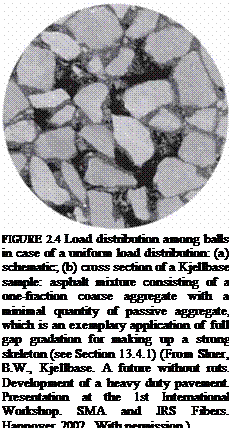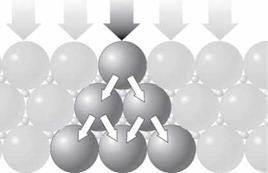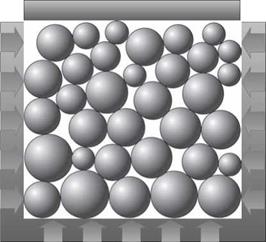FORMATION OF A COARSE AGGREGATE SKELETON
What is the reason for developing mixes with stronger mineral skeletons? Surely it is because of heavier and heavier traffic. Not only have axle loads and traffic volumes grown steadily, but the structures of vehicle tires have also changed. The increased popularity of super single tires, for example, has changed the level of stresses applied to pavements. Obviously all those factors magnify the requirements for asphalt mixtures.
A well-known example can be used to present the SMA mineral skeleton structure. If we put some coarse grains in a pot (Figure 2.3), compact and then load them, we shall obtain a structure with high compressive strength, depending on the aggregate’s fragmentation (crushing) resistance. A distinctive feature of such a compacted collection of coarse grains is the full and uninterrupted contact between them. This type of skeleton might be desirable for an asphalt surface mixture to provide a strong structure.
Now let us look at Figure 2.4, which presents a schematic showing how a load is carried by a mineral skeleton (of a surface course), assuming full grain contact. The transfer of load by adjacent grains through contact points between the coarse particles may be seen. If these contact points between coarse aggregate particles are not present, the finer particles will have to help carry the load, which results in the
|
FIGURE 2.3 Vertically loaded grains with side support (as in a crushing resistance test of coarse aggregates). |

 |
(b)
development of a discontinuous load transfer by coarse, active grains and potentially weakens the whole structure.
Looking at Figures 2.3 and 2.4, we may notice one of the SMA’s characteristic features. During the compaction process on a construction site, the aggregate grains in the SMA skeleton are forced into direct contact. The coarse grains are brought into contact with each other, making the desired skeleton. Once that contact occurs, further compaction may be harmful. Why? Because it will crush grains. Let us look once again at Figure 2.3. Since the skeleton has already come into existence, further compacting will only lead to crushing grains. In other words, an SMA mixture has
to be skillfully compacted in such a way that the coarse grains are properly placed, securing stone-to-stone contact. This principle applies to compacting energy on a construction site, as well as in a laboratory.
To conclude our examination of the formation of an SMA skeleton, it is worth noting an idea put forth by Van de Ven et al. (2003), who said that there is probably no real, 100% stone-to-stone contact in a newly compacted SMA and that the coarse grains are separated from each other by the finest grains of filler, sand, and thin binder film. This means that there is an enlarging effect[3] of the volume of voids in the stone skeleton. The final arrangement of grains comes after some time under the influence of traffic and temperature of the layer. Small grains (sand and filler) can be crushed or moved, and the void content in SMA decreases.
Let us also bear in mind that the more stable a mineral skeleton is, the less susceptible it will be to deformation. Even when the binder softens due to the increased temperature of the pavement, the layer will not necessarily be deformed if there is an adequate blend of aggregates. The weaker the skeleton and the higher the temperature, the greater is the role of the mastic’s shear strength, and the more reason for reinforcing the mastic with polymers or special fibers.







Leave a reply